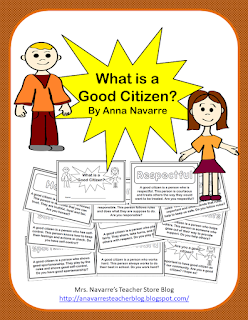Teaching good citizenship in the classroom is important for building a strong classroom community. We want students to understand that every member of the community, which are all of the students in the classroom and even those outside of the classroom, follows rules that help the community to function as a team.
Teaching citizenship in the classroom usually happens at the beginning of the school year. Teachers explain to students basic classroom rules and expectations. Teachers know the importance of doing this right away, but we know that it is not a one-time thing. Teaching citizenship is done daily as we model and reinforce acceptable behavior. This is done more informally and more indirectly than at the beginning of the school year. But, it is sometimes necessary to go back and review classroom rules and expectations more directly, such as after a long holiday break.
How do we teach good citizenship? Well, there are many ideas and resources for teaching good citizenship, but it is easiest to start with what students already know. Begin with the idea that we work to be good citizens every day in our day-to-day life. We follow a set of rules that allows us to respect and interact with each other. We follow rules that keep us safe and we follow rules that keep us out of trouble. There are rules set up by our government and rules that we follow in our homes. We also have values such as honesty, compassion, respectfulness, fairness, loyalty, tolerance, etc. These are things that are part of being a good citizen.
Once students are reminded that we work to be good citizens every day it is easy to build the understanding that we need to be good citizens in the classroom as well. You can use books and videos that talk about following rules and being good citizens, which is always a great way for students to get a better understanding and see examples of good citizens. Along with the books, videos, and discussions you definitely want to begin introducing your classroom rules and expectations.
Find fun ways to teach students citizenship. You can role-play and model what good and bad citizenship looks like. Have students brainstorm ideas and provide examples. You can have them partner share, draw pictures, and write a word. One fun activity is what I call "Strike a Pose." Write some words on slips of paper or index cards. Put them in a bag or a container. Draw a card and then have students strike a pose. For example, the "respectful" card is drawn. Students strike a pose to show what that looks like. I would probably take a bow in front of someone. There is no right or wrong pose. It is just an idea for thinking about keywords. You could even preview the words and talk about what pose would work well before playing this game.
Matching games with pictures or words is another fun activity. There are matching games that can be purchased, but you can easily make your own matching games. Again, you could write words on index cards (two of each word) and have students match them. You could also find pictures online, or take pictures. Remember, you want two of each.
There are a couple other resources that I like to use. The first one kind of goes along with the drawing and writing idea that I talked about earlier. It is a resource that focuses on the different character traits of a good citizen. Each page provides a definition of the character trait and then provides a space for students to draw a picture and write a couple of sentences about the trait.

I also like to use a booklet that helps students learn about the character traits of a good citizen. It is an 11 page booklet that works well as a small group reader.
It doesn't really matter how you decide to teach good citizenship or what resources you choose to use, the key is to keep the idea of building a strong community in mind. Remind students to think about who the people in their community are; how they expect these people to act; and what their role/responsibility as part of this community is. Believe me, setting the ideas of community and being good citizens in place will help to ensure a great school year.


No comments:
Post a Comment